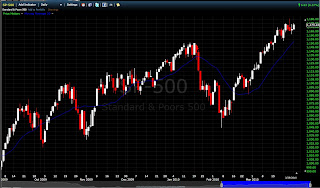 Interesting post from the Kirk report.
Interesting post from the Kirk report.While many times market activity cannot and should not be entirely explained and understood in relation to simple news events (Mr. Market is far more complex), here’s a listing of the most significant bullish & bearish factors, news-focused resources indicate that we’ve seen over the past couple of weeks:
Bullish Factors: •Unexpected increase in retail sales
•Analyst predictions for expanding U.S. payrolls
•Slack inflation pressures reported in both CPI & PPI
•Fed promises that interest rates will remain “exceptionally low” for an “extended period”
•Analysts raise earnings & profit forecasts
•Reduced sovereign debt concerns especially over Greece
•Increasing dividend payouts
•Very positive comments about the recovery from executives like the CEO of Fedex
•Barton Biggs predicts another 10% gain due to performance pressure by underinvested fund managers
•Richard Bove said bank stocks may quadruple over the next two to three years as loan defaults decrease
•Fedspeak from Bullard who sees significant jobs improvement
•Better than expected economic reports ranging from durable goods to a larger decline in weekly initial unemployment claims
•Increase in Q4 US corporate profits by $108.7 billion to $1.47 trillion as earnings surged +31% from the same period in 2008
•Prediction from the WTO that global commerce will grow by +9.5% this year from last year fueled by growth in Asia and India
•Prediction from Birinyi Associates that the S&P 500 Index will climb to 1,325 by year-end
•Euro-Zone economic confidence surged
•Companies in the S&P 500 Index spent $47.8 billion on stock buybacks during Q4 of 2009 which is up +37%
•New government programs to help US homeowners avoid foreclosure
•Better housing market as smaller-than-expected decrease in existing home sales
•Chipmakers see signs of increased demand
•Signs of a bottom in U.S. commercial property as values rose 1%
•Strength in health-care companies due to health care reform
•US is unlikely to lose its top AAA credit rating
Bearish Factors: •Concern that stock prices are overextended
•Concern that China’s economy may slow and crimp the global economy after China’s Premier Wen Jiabao said that ballooning sovereign debt and high unemployment worldwide could send the global economy into a “double dip” slump
•Prediction from Morgan Stanley that it expects “multiple” increases in China’s bank-reserve ratio requirements and higher interest rates in China as early as next month
•Weakened foreign demand for US equities after net foreign purchases of US stocks dropped -79%
•Decrease in the March NAHB housing market index which matched an 11-month low
•The unexpected decline in March US University of Michigan consumer confidence
•A decrease in the safe-haven demand for Treasuries
•Jump in yield on the 10-year T-note which raises the cost of capital for consumers and businesses
•Prediction from the Center for Global Energy Studies that crude prices will fall 25% to $60 a barrel in Q4 as OPEC members continue to disregard their quotas and overproduce
•Fed’s post-FOMC statement that reaffirmed it will end its asset-purchase program at the end of this month
•Prediction from economist Stiglitz that the Fed’s decision to stop purchasing mortgage-debt will drive up mortgage rates and worsen the housing crisis
•The unexpected action by the Reserve Bank of India to raise interest rates for the first time in almost two years
•Prediction from Brusuelas Analytics that the US unemployment rate will rise to 10.2% in Q3 and probably won’t fall below 9% until the end of next year
•Concerns that ever-increasing global debt levels may slow economic growth
•IMF said that advanced economies face “acute” challenges in tackling high public debt and that maintaining government debt at post-crisis levels might reduce growth in advanced economies by as much as half a percentage point
•The 312,000 surge in inventory of US existing homes for sale in February the biggest monthly increase in almost two years
•Prediction from Raymond James & Associates that the housing market “is in a fragile recovery that needs to see job growth to get a sustainable rebound”
•Comments from Geithner who said housing and the economy remain damaged and it will take “a long time” to repair the harm as the administration takes steps to overhaul industry financing and regulation
•Fitch Ratings cut Portugal’s credit rating to AA- from AA and keep its outlook on Portugal’s debt rating “negative,” which renews concern that Greece’s fiscal crisis will spread to other European countries and hamper a global recovery
•The unexpected decline in Feb US new home sales which fell to their lowest level since records began in 1963
•Prediction from ECB Governing Council member Wellink that the global economy could falter again before resuming its recovery as “private consumption and investments continue to decline or stagnate and this poses the risk that the economic recovery makes a false start and will be W-shaped”
•The unexpected downward revision to Q4 US GDP
•Data from the US Labor Department that showed unemployment rising in 27 US states last month suggesting that broad-based hiring has yet to develop
•Comments from Fed Governor Warsh who said the US faces “significant economic challenges”
•Geopolitical concerns after a South Korean naval vessel was sunk near the border of North Korea
•Weaker-than-expected US Feb personal income report which may signal a decrease in consumer spending in the months ahead
•Treasury said it plans to sell the government’s 27% stake in Citigroup this year using a “pre-arranged written trading plan”
Overall, I’d have to say that, at least in quick review, I don’t see anything here that is a tremendous surprise. I suppose in a small way that helps explain how calm the markets have been of late and why we remain below 20 in the VIX.









